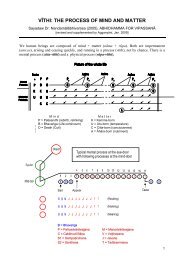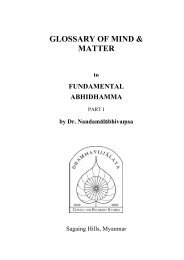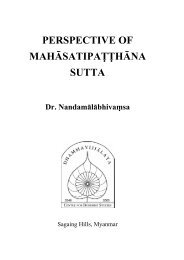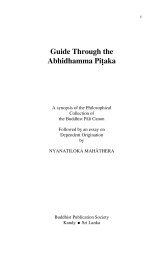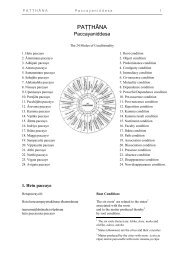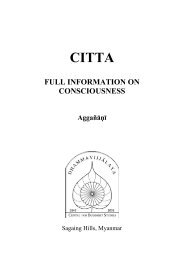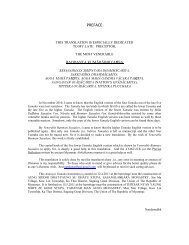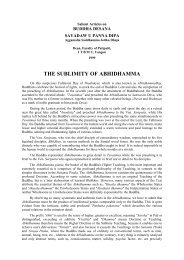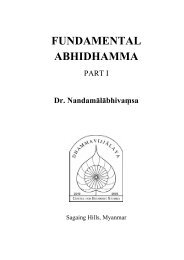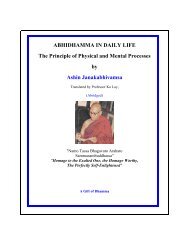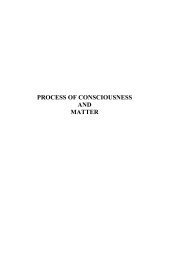Mahathera Ledi Sayadaw - Abhidhamma.com
Mahathera Ledi Sayadaw - Abhidhamma.com
Mahathera Ledi Sayadaw - Abhidhamma.com
Create successful ePaper yourself
Turn your PDF publications into a flip-book with our unique Google optimized e-Paper software.
o<br />
o<br />
o<br />
o<br />
Synchrony of Relations in the Immoral Class of Consciousness<br />
Synchrony of Relations in the States of Mind<br />
Synchrony of Relations in the Groups of Material Qualities<br />
PREFACE to the published book (now out of print)<br />
Buddhism views the world, with the exception of Nibbana and pannatti, to be impermanent, liable<br />
to suffering, and without soul-essence. So Buddhist philosophy, to elaborate the impermanency as<br />
applied to the Law of Perpetual Change, has from the outset dissolved all things, all phenomena<br />
both psychical and physical, into a continuous succession of happenings, of states (sabhava) of<br />
mind and matter, under the Fivefold Law of Cosmic Order (niyama). And the happenings are<br />
determined and determining, both as to their constituent states and as to other happenings, in a<br />
variety of ways, which Buddhist Philosophy expresses by the term 'paccaya' or 'relations.' One<br />
<strong>com</strong>plex happening of mental and material states, with its three phases of time--genesis or birth,<br />
cessation or death and a static interval between--is followed by another happening, wherein there<br />
is always a causal series of relations. Nothing is casual and fortuitous. When one happening by its<br />
arising, persisting, cessation, priority, and posteriority, is determined by and determining another<br />
happening by means of producing (janaka), supporting (upathambhaka), and maintaining<br />
(anupalana), the former is called the relating thing (paccaya-dhamma), the latter the related thing<br />
(paccayuppanna-dhamma), and the determination or the influence or the specific function is called<br />
the correlativity (paccayasatti). As the various kinds of influence are apparently known, the<br />
relations are classified into the following 24 species:<br />
31. Hetu--condition or root<br />
32. Arammana--object<br />
33. Adhipati--dominance<br />
34. Anantara--contiguity<br />
35. Samanantara--immediate contiguity<br />
36. Sahajali--coexistence<br />
37. Annamanna--reciprocity<br />
38. Nissaya--dependence<br />
39. Upanissaya--sufficing condition<br />
40. Purejata--pre-existence<br />
41. Pacchajata--causal relation of posteriority in time<br />
42. Asevana--habitual recurrence<br />
43. Kamma--kamma or action<br />
44. Vipaka--effect<br />
45. Ahara/--food<br />
46. Indriya--control<br />
47. Jhana--jhana or ecstacy<br />
48. Magga--path<br />
49. Sampayutta--association<br />
50. Vippayutta--dissociation<br />
51. Atthi--presence<br />
52. Natthi/--absence<br />
53. Vigata--abeyance<br />
54. Avigata--continuance<br />
These 24 species of relations are extensively and fully expounded in the seventh and last of the<br />
analytical works in the <strong>Abhidhamma</strong> Pitaka of the Buddhist Canon, called the Patthana ('The<br />
Eminence'), or the Maha-Pakarana ('The Great Book').




